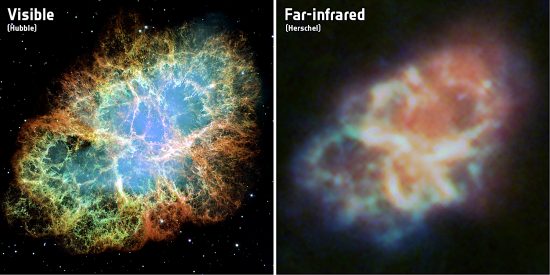
April 10, 2020
Most interplanetary dust is thought to be “recycled”.
In other words, it is the material out of which the Solar System was made. According to astrophysicists, in earlier epochs, as well as today, the Solar System’s most common element was hydrogen, with magnesium, silicon, and iron composing most of the rocky planets and moons. That hydrogen condensed into the primitive Sun, which is representative of its type as astronomers classify stars: a yellow-orange main sequence star about a quarter of the way through its life.
It appears that some materials in the Solar System’s planets can only form at blast furnace heat, while other grains can only form at much lower temperatures. A single interplanetary dust grain reveals, in many cases, that it formed in different locations and at different times.
Conventional viewpoints suggest that supernovae send shockwaves into star-forming regions, compressing the wispy dust and gas. That process is what astronomers say “jump-starts” star formation. Although, how shock waves travel through the incredibly rarified medium of interstellar space until they encounter a nebular cloud is not known.
Free-floating nebular dust is just 0.1 microns in size, or smaller than the wavelength of blue light at 0.45 microns. According to the “cosmic dust cycle”, some stars blow off incredible quantities of dust when they explode.
For instance, on February 23, 1987 a supernova known as 1987A exploded in the Large Magellanic Cloud, illuminating a ring of dust many times larger than the Solar System. The explosion was so powerful that it glowed in visible, extreme ultraviolet, and X-ray wavelengths. In 2010 The Herschel Space Observatory found dust in the ring measuring -100 Celsius and -250 Celsius. The quantity of cold dust present is mind-boggling: 6×10^30 kilograms—more than 200,000 Earths!
When physicists at NASA Ames Research Center created particles of dust, they used a device known as the Cosmic Simulation Chamber (COSmIC). They injected a low-temperature spray of hydrocarbon molecules into a vacuum chamber, where they were blasted with an electric discharge. Particles about 10 nanometers in size were formed, with some as large as 1.5 micrometers in diameter, about a tenth the width of a human hair.
So, astrophysicists believe cosmic dust forms in supernovae, or as a result of supernovae shockwaves, and scientists use cold vacuum and powerful electric discharges to recreate those events. What conclusions can be drawn?
The Picture of the Day makes a point that stars are composed of plasmas, the “fourth state” of matter. Plasma is ionized: one or more electrons are stripped from the atoms in its substance, making it electrically charged. As written many times, plasma does not behave like pressurized gas, it behaves according to the tenets of plasma physics.
Laboratory experiments confirm that electricity flowing through plasma forms double layers. This is the “charge separation” so often mentioned in these pages. Could charge separation be the foundation for the electrical explosions known as supernovae? In an electrically charged plasma star, explosions occur because of double layer breakdowns. A star’s power comes from external currents of electric charge flowing through vast circuits in space. Supernovae are the result of a stellar “circuit breaker”, where the stored electromagnetic energy in the circuit is suddenly focused at one point.
When a star’s double layer explodes, the electromagnetic energy stored in its galactic circuit surges into the explosion. The resulting supernova radiation is emitted across the entire electromagnetic spectrum from radio to gamma rays. So, it is electricity that causes the stars to shine, and it is electricity that causes them to explode. If dust is formed in supernovae, it is ironic that consensus science needs an electric discharge to create it in the laboratory.
Stephen Smith
The Thunderbolts Picture of the Day is generously supported by the Mainwaring Archive Foundation.












